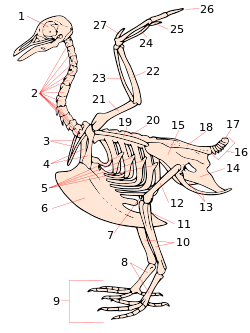Tarsometatarsus

The tarsometatarsus is a bone that is only found in the lower leg of birds and certain non-avian dinosaurs.
It is formed from the fusion of several bones found in other types of animals, and homologous to the mammalian tarsal (ankle) and metatarsal (foot) bones. Despite this, the tarsometatarsus of birds is often referred to as just the tarsus or metatarsus.
There are several ways and extents in which the tarsometatarsal fusion is accomplished throughout bird evolution. Namely, in Neornithes (modern birds) the fusion is most thorough at the distal (metatarsal) end though present along the entire length of the bone. In the Enantiornithes, a group of Mesozoic birds, the fusion was complete at the proximal (tarsal) end but the distal metatarsi still were somewhat separate.

While birds are the best-known animals with this fused bone, they were not the only group and not even the first to have it: in a remarkable case of parallel evolution, a tarsometatarsus was also present in the Heterodontosauridae, a group of tiny ornithischian dinosaurs quite unrelated to birds. Their oldest remains date from the Late Triassic more than 200 million years ago, and predate the first birds with a tarsometatarsus by nearly 100 million years.
References
- Proctor NS, Peterson RJ and Lynch PJ (1993) Manual of Ornithology: Avian Structure and Function. New Haven, CT: Yale University Press.